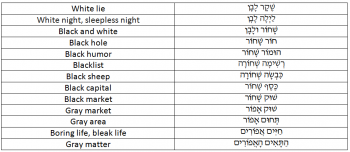Hebrew Colors’ Names: Black, White and Gray Posted by Ayana on Oct 28, 2019 in Uncategorized
Colors’ names are very useful in daily spoken language, they are among the first words every language learner memorizes. Today we’ll delve into three basic colors: black, white and gray.
שָׁחֹור (black), לָבָן (white) and אָפֹור (gray) are the singular masculine forms of these colors. The Hebrew language has a grammatical gender. Every noun and pronoun has a gender – masculine or feminine. There is nothing male or female about objects, but when talking about them the verbs and adjectives should conjugate corresponding to their gender. When describing feminine nouns or pronouns, שָׁחֹור, לָבָן וְאָפֹור should appear in their feminine forms:

For example:
יֵשׁ לׅי כּוֹבַע שָׁחֹור וְיֵשׁ לׅי כּוֹבַע אָפֹור. אֵיזֶה אַתָּה מַעְדׅיף?
I have black hat and gray hat. Which one do you prefer?
הׅתְלַבַּטְנוּ אׅם לׅקְנוֺת מְכוֹנִית שְׁחֹורָה אוֺ לְבָנָה.
We debated whether to buy a black or a white car.
אֲנִי חוֺשֶׁבֶת שֶׁלַזָּ’קֶט הַשָּׁחֹור תַּתְאׅים עֲנִיבָה שְׁחֹורָה.
I think a black tie will fit the black jacket.
In Hebrew, adjectives and verbs are also conjugated according to the distinction of singular and plural of the pronoun or noun. If the subject appears in its singular, so will the adjective describing it. If the subject appears in its plural form, so will the verb referring to it. When describing plural nouns or pronouns, שָׁחֹור, לָבָן וְאָפֹור should appear in their plural forms:

For example:
כַּמָּה חוּלְצוֺת אֲפֹורוֹת יֵשׁ לְךָ?
How many gray shirts do you have?
הׅזְמַנְתּׅי עֲשָׂרָה כּׅיסָאוֺת שְׁחֹורִים לְחֲדַר הַיְּשׁׅיבוֺת.
I ordered ten black chairs for the conference room.
מַרְבָד שֶׁל כָּלָנׅיּוֺת לְבָנוֹת בֵּין הָעֵצׅים הוּא מַרְאֶה מַרְהִיב.
A gather of white anemones among the trees is a spectacular sight.
In Hebrew, nouns are made definite by adding the prefix ה’ הַיְּדׅיעָה (hey hayedia). The prefix ה functions like the definite article the in English. The word עִיתּוֹן (newspaper), for example, indicates any newspaper; while the word הָעׅיתּוֹן (the newspaper) refers to a specific newspaper. In English, when a combination of a noun and its modifying adjective is made definite, the definite article the appears before the phrase. In Hebrew, the hey haydia definite article prefix appears twice. It precedes both the noun and the adjective. The same is true when the adjective is a color.
For example:
לְחֲדַר הָעֲבוֹדָה בָּחַרְתִּי אֶת הַשּׁוּלְחָן הַלָּבָן.
For the study room I chose the white desk.
אֲנִי חוֺשֵׁב שֶׁהָעֲנִיבָה הָאֲפֹורָה יוֺתֵר מַתְאִימָה לָאֵרוּעַ.
I think the gray tie is more appropriate for the event.
הָאוֹתִיּוֹת הַשְּׁחֹורוֹת בָּלְטוּ עַל רֶקַע הַדַּף הַלָּבָן.
The black letters stood out against the white page.
Colors have inspired the formation of several metaphors and similes in many languages. They are used metaphorically to convey a feeling or to describe an atmosphere. Here are some Hebrew phrases composed of the colors black, white and gray.

Keep Calm and Learn Hebrew!

Build vocabulary, practice pronunciation, and more with Transparent Language Online. Available anytime, anywhere, on any device.





Comments:
Amelie:
I do not even know how I nded up right here, but I thought this publish used
to be good. I do not reognise whho you are but definitey you’re going to a well-known blogger in case you
aren’t already. Cheers! Best ed pills non prescription sildenafil price over the counter eed pills
Phillipp:
After I originally commented I appear to have clicked on the -Notify me when new
comments are added- checkbox and frkm now on each time a comment is added I recieve 4 emails with the same comment.
Perhaps there is a mezns youu can remove me
from that service? Appreciate it! Viagra 50
mgg generic Viagra walmart cheap Viagra